Support Teaching and Learning
VerifiedAdded on 2022/08/24
|9
|2545
|18
AI Summary
Contribute Materials
Your contribution can guide someone’s learning journey. Share your
documents today.
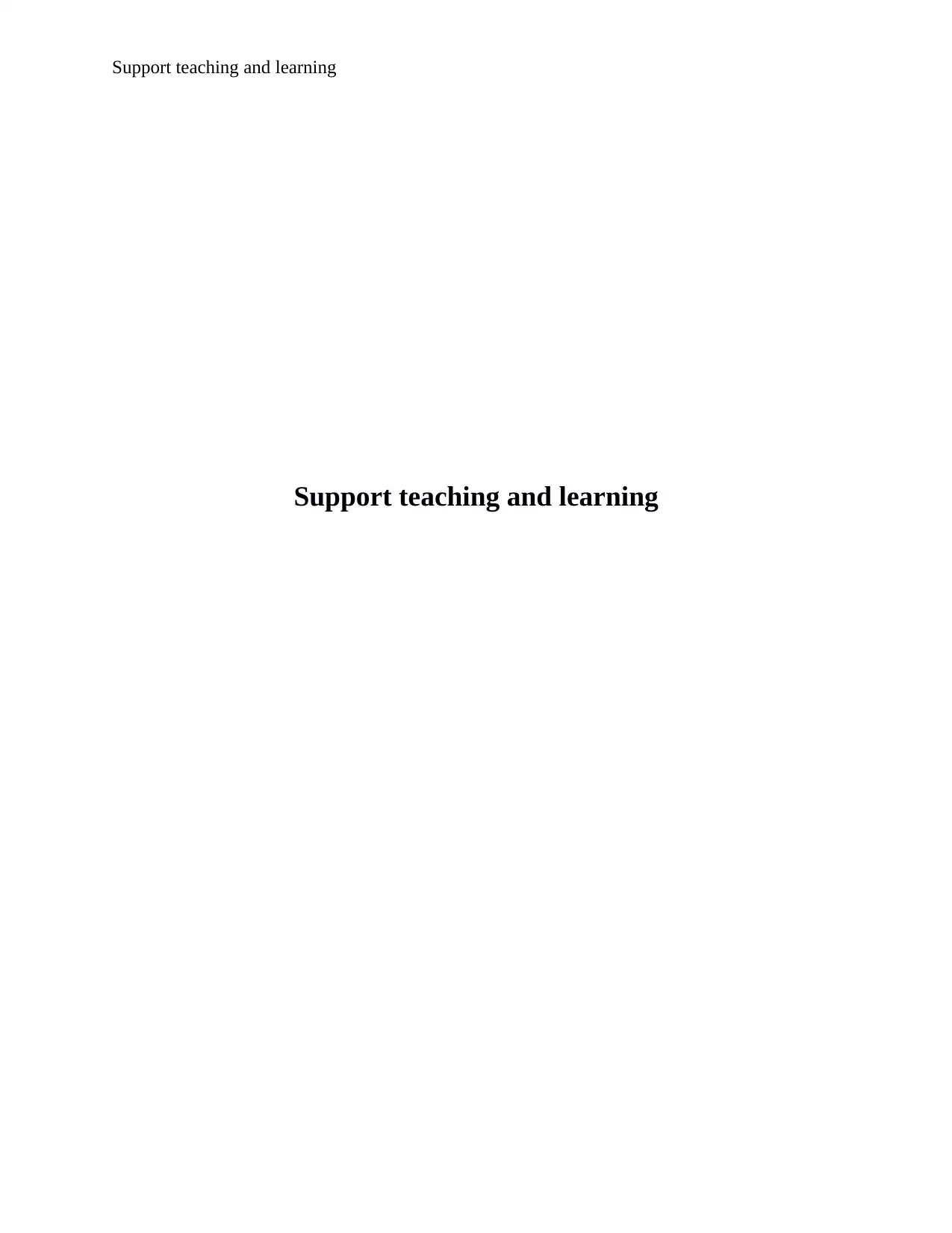
Support teaching and learning
Support teaching and learning
Support teaching and learning
Secure Best Marks with AI Grader
Need help grading? Try our AI Grader for instant feedback on your assignments.
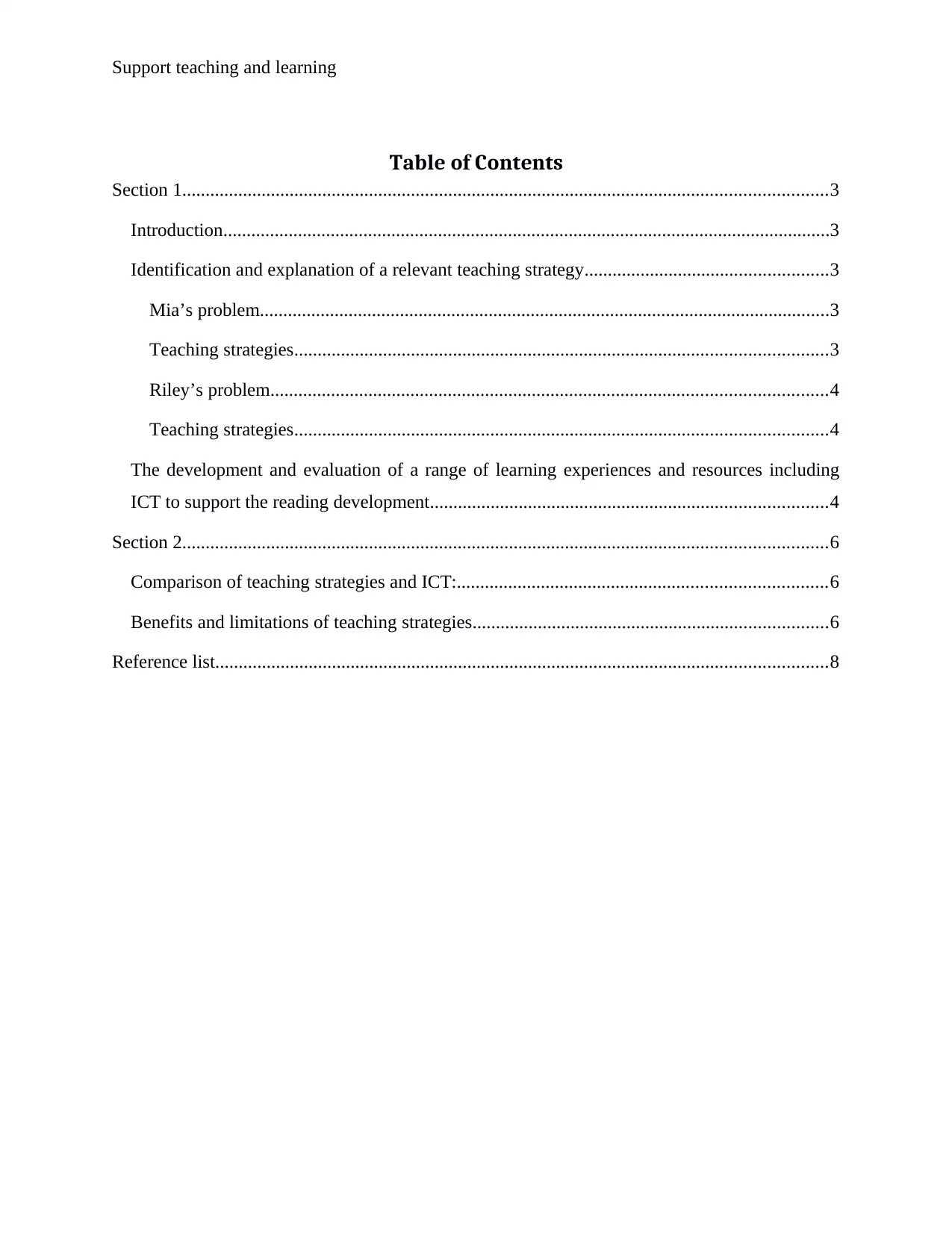
Support teaching and learning
Table of Contents
Section 1..........................................................................................................................................3
Introduction..................................................................................................................................3
Identification and explanation of a relevant teaching strategy....................................................3
Mia’s problem..........................................................................................................................3
Teaching strategies..................................................................................................................3
Riley’s problem.......................................................................................................................4
Teaching strategies..................................................................................................................4
The development and evaluation of a range of learning experiences and resources including
ICT to support the reading development.....................................................................................4
Section 2..........................................................................................................................................6
Comparison of teaching strategies and ICT:...............................................................................6
Benefits and limitations of teaching strategies............................................................................6
Reference list...................................................................................................................................8
Table of Contents
Section 1..........................................................................................................................................3
Introduction..................................................................................................................................3
Identification and explanation of a relevant teaching strategy....................................................3
Mia’s problem..........................................................................................................................3
Teaching strategies..................................................................................................................3
Riley’s problem.......................................................................................................................4
Teaching strategies..................................................................................................................4
The development and evaluation of a range of learning experiences and resources including
ICT to support the reading development.....................................................................................4
Section 2..........................................................................................................................................6
Comparison of teaching strategies and ICT:...............................................................................6
Benefits and limitations of teaching strategies............................................................................6
Reference list...................................................................................................................................8
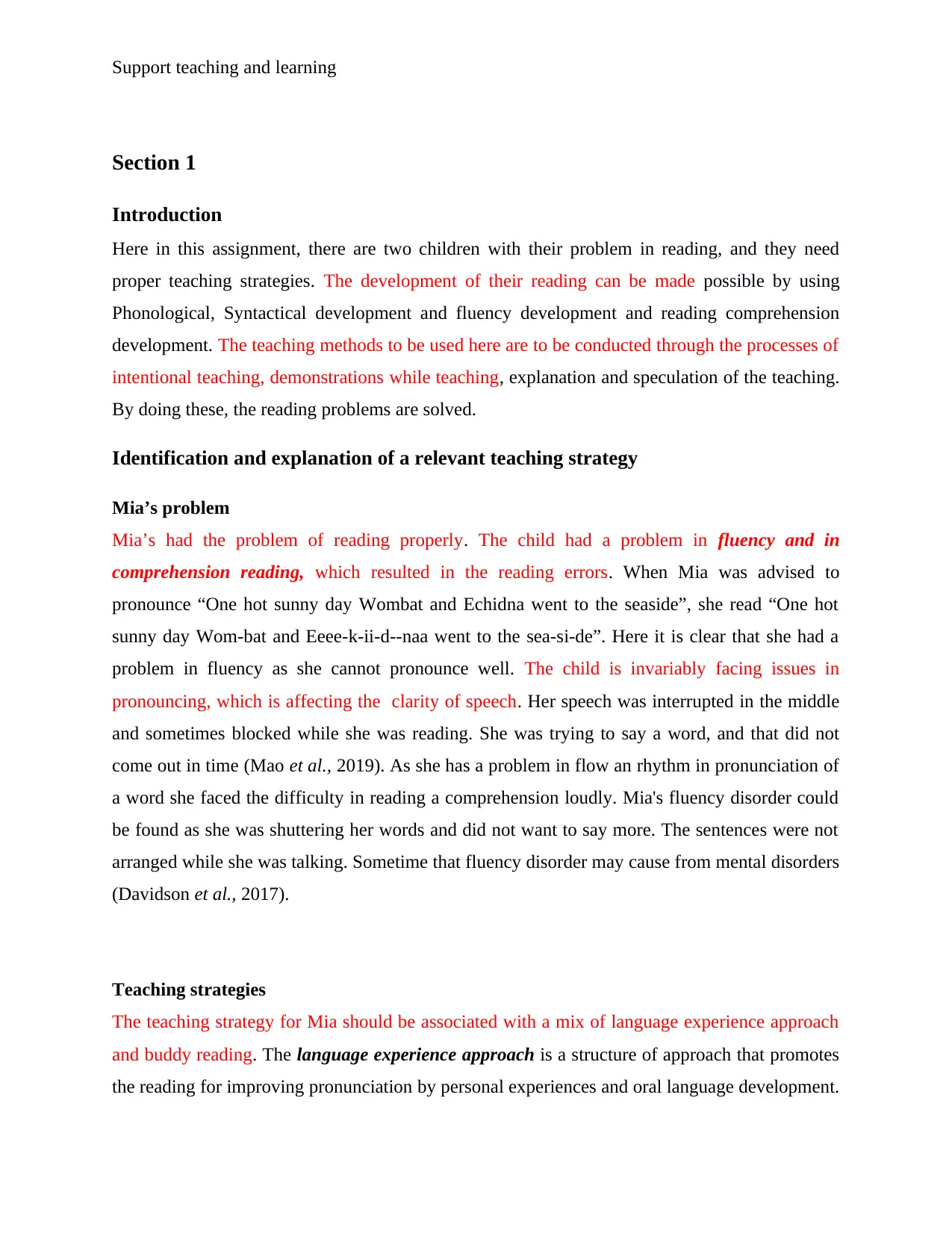
Support teaching and learning
Section 1
Introduction
Here in this assignment, there are two children with their problem in reading, and they need
proper teaching strategies. The development of their reading can be made possible by using
Phonological, Syntactical development and fluency development and reading comprehension
development. The teaching methods to be used here are to be conducted through the processes of
intentional teaching, demonstrations while teaching, explanation and speculation of the teaching.
By doing these, the reading problems are solved.
Identification and explanation of a relevant teaching strategy
Mia’s problem
Mia’s had the problem of reading properly. The child had a problem in fluency and in
comprehension reading, which resulted in the reading errors. When Mia was advised to
pronounce “One hot sunny day Wombat and Echidna went to the seaside”, she read “One hot
sunny day Wom-bat and Eeee-k-ii-d--naa went to the sea-si-de”. Here it is clear that she had a
problem in fluency as she cannot pronounce well. The child is invariably facing issues in
pronouncing, which is affecting the clarity of speech. Her speech was interrupted in the middle
and sometimes blocked while she was reading. She was trying to say a word, and that did not
come out in time (Mao et al., 2019). As she has a problem in flow an rhythm in pronunciation of
a word she faced the difficulty in reading a comprehension loudly. Mia's fluency disorder could
be found as she was shuttering her words and did not want to say more. The sentences were not
arranged while she was talking. Sometime that fluency disorder may cause from mental disorders
(Davidson et al., 2017).
Teaching strategies
The teaching strategy for Mia should be associated with a mix of language experience approach
and buddy reading. The language experience approach is a structure of approach that promotes
the reading for improving pronunciation by personal experiences and oral language development.
Section 1
Introduction
Here in this assignment, there are two children with their problem in reading, and they need
proper teaching strategies. The development of their reading can be made possible by using
Phonological, Syntactical development and fluency development and reading comprehension
development. The teaching methods to be used here are to be conducted through the processes of
intentional teaching, demonstrations while teaching, explanation and speculation of the teaching.
By doing these, the reading problems are solved.
Identification and explanation of a relevant teaching strategy
Mia’s problem
Mia’s had the problem of reading properly. The child had a problem in fluency and in
comprehension reading, which resulted in the reading errors. When Mia was advised to
pronounce “One hot sunny day Wombat and Echidna went to the seaside”, she read “One hot
sunny day Wom-bat and Eeee-k-ii-d--naa went to the sea-si-de”. Here it is clear that she had a
problem in fluency as she cannot pronounce well. The child is invariably facing issues in
pronouncing, which is affecting the clarity of speech. Her speech was interrupted in the middle
and sometimes blocked while she was reading. She was trying to say a word, and that did not
come out in time (Mao et al., 2019). As she has a problem in flow an rhythm in pronunciation of
a word she faced the difficulty in reading a comprehension loudly. Mia's fluency disorder could
be found as she was shuttering her words and did not want to say more. The sentences were not
arranged while she was talking. Sometime that fluency disorder may cause from mental disorders
(Davidson et al., 2017).
Teaching strategies
The teaching strategy for Mia should be associated with a mix of language experience approach
and buddy reading. The language experience approach is a structure of approach that promotes
the reading for improving pronunciation by personal experiences and oral language development.
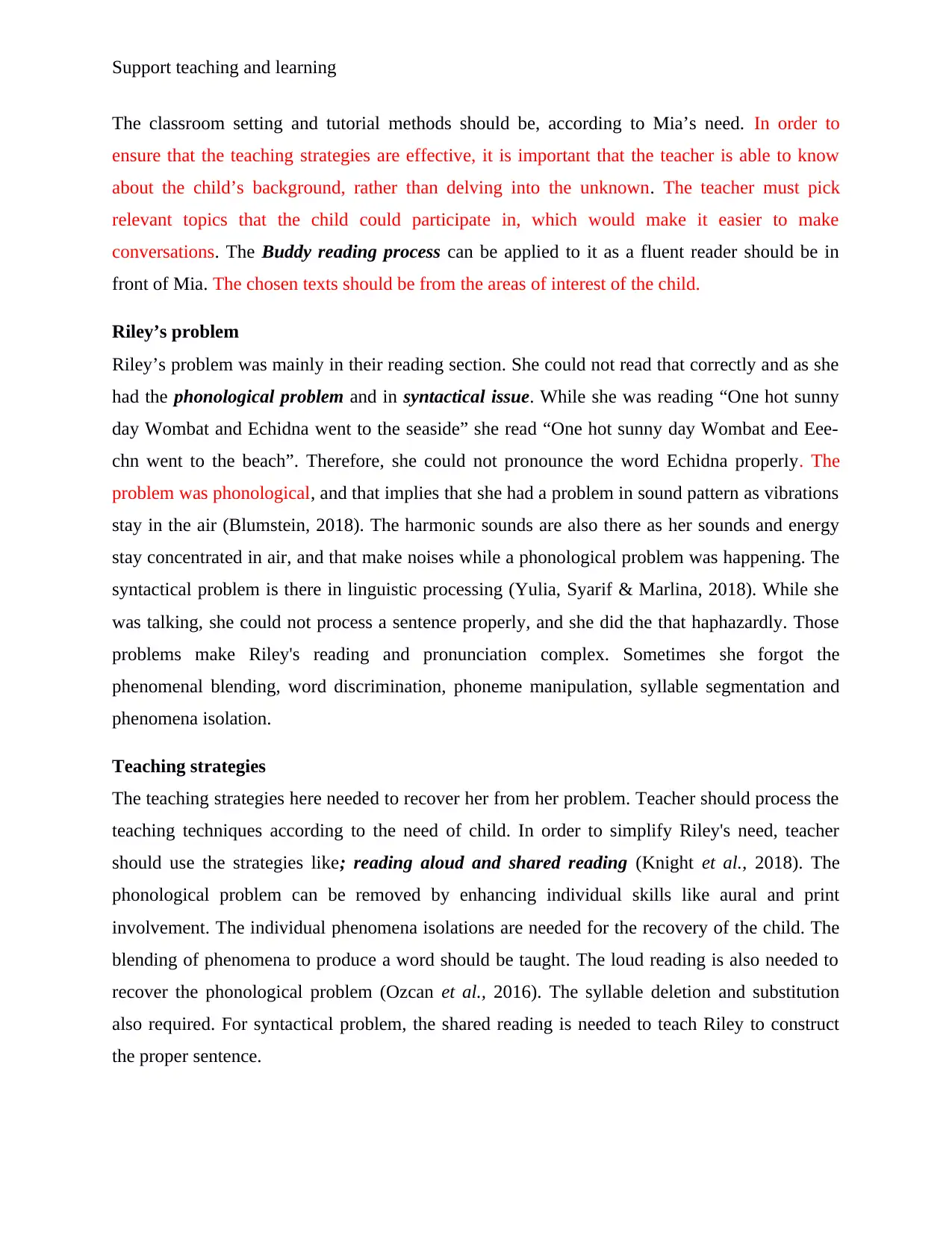
Support teaching and learning
The classroom setting and tutorial methods should be, according to Mia’s need. In order to
ensure that the teaching strategies are effective, it is important that the teacher is able to know
about the child’s background, rather than delving into the unknown. The teacher must pick
relevant topics that the child could participate in, which would make it easier to make
conversations. The Buddy reading process can be applied to it as a fluent reader should be in
front of Mia. The chosen texts should be from the areas of interest of the child.
Riley’s problem
Riley’s problem was mainly in their reading section. She could not read that correctly and as she
had the phonological problem and in syntactical issue. While she was reading “One hot sunny
day Wombat and Echidna went to the seaside” she read “One hot sunny day Wombat and Eee-
chn went to the beach”. Therefore, she could not pronounce the word Echidna properly. The
problem was phonological, and that implies that she had a problem in sound pattern as vibrations
stay in the air (Blumstein, 2018). The harmonic sounds are also there as her sounds and energy
stay concentrated in air, and that make noises while a phonological problem was happening. The
syntactical problem is there in linguistic processing (Yulia, Syarif & Marlina, 2018). While she
was talking, she could not process a sentence properly, and she did the that haphazardly. Those
problems make Riley's reading and pronunciation complex. Sometimes she forgot the
phenomenal blending, word discrimination, phoneme manipulation, syllable segmentation and
phenomena isolation.
Teaching strategies
The teaching strategies here needed to recover her from her problem. Teacher should process the
teaching techniques according to the need of child. In order to simplify Riley's need, teacher
should use the strategies like; reading aloud and shared reading (Knight et al., 2018). The
phonological problem can be removed by enhancing individual skills like aural and print
involvement. The individual phenomena isolations are needed for the recovery of the child. The
blending of phenomena to produce a word should be taught. The loud reading is also needed to
recover the phonological problem (Ozcan et al., 2016). The syllable deletion and substitution
also required. For syntactical problem, the shared reading is needed to teach Riley to construct
the proper sentence.
The classroom setting and tutorial methods should be, according to Mia’s need. In order to
ensure that the teaching strategies are effective, it is important that the teacher is able to know
about the child’s background, rather than delving into the unknown. The teacher must pick
relevant topics that the child could participate in, which would make it easier to make
conversations. The Buddy reading process can be applied to it as a fluent reader should be in
front of Mia. The chosen texts should be from the areas of interest of the child.
Riley’s problem
Riley’s problem was mainly in their reading section. She could not read that correctly and as she
had the phonological problem and in syntactical issue. While she was reading “One hot sunny
day Wombat and Echidna went to the seaside” she read “One hot sunny day Wombat and Eee-
chn went to the beach”. Therefore, she could not pronounce the word Echidna properly. The
problem was phonological, and that implies that she had a problem in sound pattern as vibrations
stay in the air (Blumstein, 2018). The harmonic sounds are also there as her sounds and energy
stay concentrated in air, and that make noises while a phonological problem was happening. The
syntactical problem is there in linguistic processing (Yulia, Syarif & Marlina, 2018). While she
was talking, she could not process a sentence properly, and she did the that haphazardly. Those
problems make Riley's reading and pronunciation complex. Sometimes she forgot the
phenomenal blending, word discrimination, phoneme manipulation, syllable segmentation and
phenomena isolation.
Teaching strategies
The teaching strategies here needed to recover her from her problem. Teacher should process the
teaching techniques according to the need of child. In order to simplify Riley's need, teacher
should use the strategies like; reading aloud and shared reading (Knight et al., 2018). The
phonological problem can be removed by enhancing individual skills like aural and print
involvement. The individual phenomena isolations are needed for the recovery of the child. The
blending of phenomena to produce a word should be taught. The loud reading is also needed to
recover the phonological problem (Ozcan et al., 2016). The syllable deletion and substitution
also required. For syntactical problem, the shared reading is needed to teach Riley to construct
the proper sentence.
Secure Best Marks with AI Grader
Need help grading? Try our AI Grader for instant feedback on your assignments.
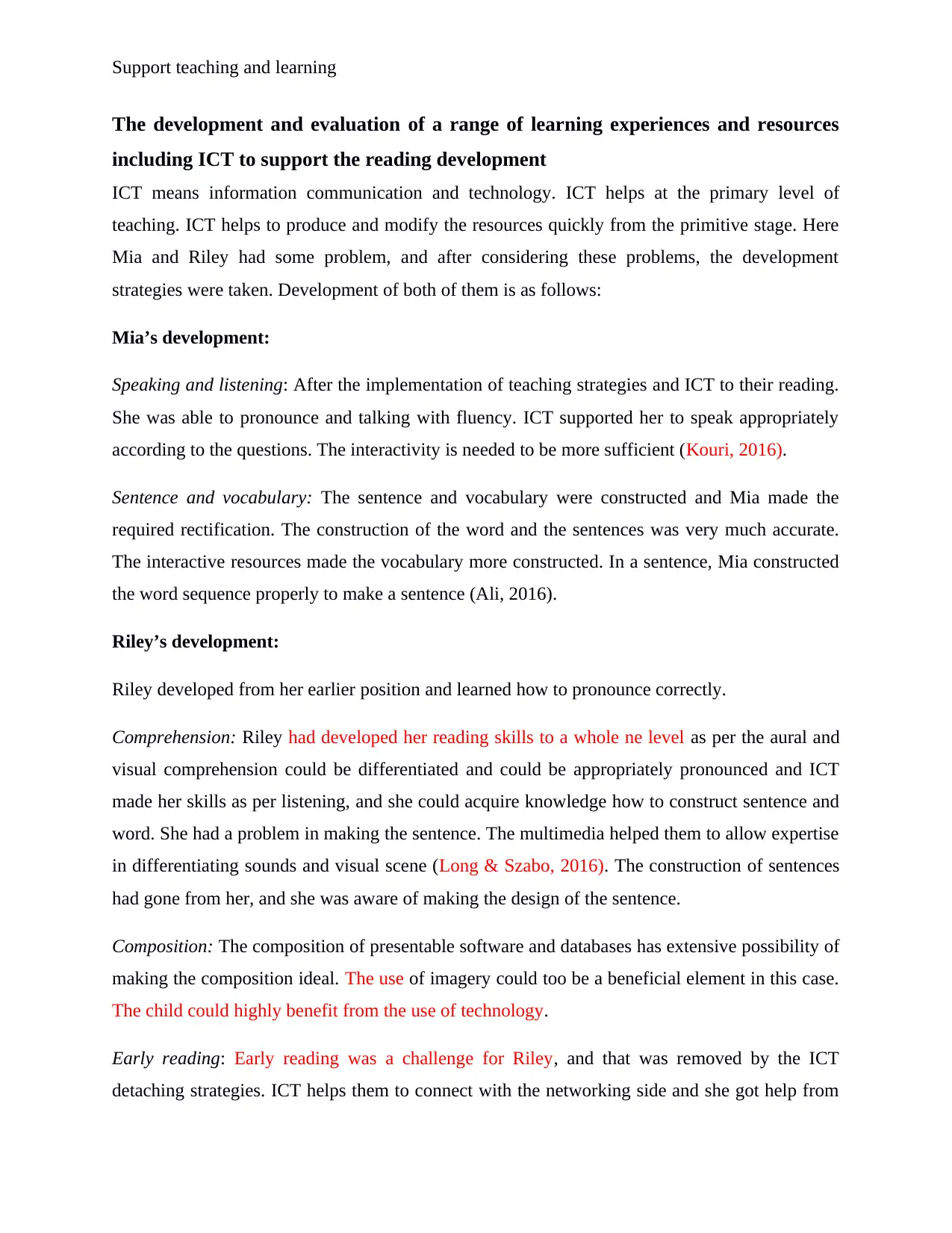
Support teaching and learning
The development and evaluation of a range of learning experiences and resources
including ICT to support the reading development
ICT means information communication and technology. ICT helps at the primary level of
teaching. ICT helps to produce and modify the resources quickly from the primitive stage. Here
Mia and Riley had some problem, and after considering these problems, the development
strategies were taken. Development of both of them is as follows:
Mia’s development:
Speaking and listening: After the implementation of teaching strategies and ICT to their reading.
She was able to pronounce and talking with fluency. ICT supported her to speak appropriately
according to the questions. The interactivity is needed to be more sufficient (Kouri, 2016).
Sentence and vocabulary: The sentence and vocabulary were constructed and Mia made the
required rectification. The construction of the word and the sentences was very much accurate.
The interactive resources made the vocabulary more constructed. In a sentence, Mia constructed
the word sequence properly to make a sentence (Ali, 2016).
Riley’s development:
Riley developed from her earlier position and learned how to pronounce correctly.
Comprehension: Riley had developed her reading skills to a whole ne level as per the aural and
visual comprehension could be differentiated and could be appropriately pronounced and ICT
made her skills as per listening, and she could acquire knowledge how to construct sentence and
word. She had a problem in making the sentence. The multimedia helped them to allow expertise
in differentiating sounds and visual scene (Long & Szabo, 2016). The construction of sentences
had gone from her, and she was aware of making the design of the sentence.
Composition: The composition of presentable software and databases has extensive possibility of
making the composition ideal. The use of imagery could too be a beneficial element in this case.
The child could highly benefit from the use of technology.
Early reading: Early reading was a challenge for Riley, and that was removed by the ICT
detaching strategies. ICT helps them to connect with the networking side and she got help from
The development and evaluation of a range of learning experiences and resources
including ICT to support the reading development
ICT means information communication and technology. ICT helps at the primary level of
teaching. ICT helps to produce and modify the resources quickly from the primitive stage. Here
Mia and Riley had some problem, and after considering these problems, the development
strategies were taken. Development of both of them is as follows:
Mia’s development:
Speaking and listening: After the implementation of teaching strategies and ICT to their reading.
She was able to pronounce and talking with fluency. ICT supported her to speak appropriately
according to the questions. The interactivity is needed to be more sufficient (Kouri, 2016).
Sentence and vocabulary: The sentence and vocabulary were constructed and Mia made the
required rectification. The construction of the word and the sentences was very much accurate.
The interactive resources made the vocabulary more constructed. In a sentence, Mia constructed
the word sequence properly to make a sentence (Ali, 2016).
Riley’s development:
Riley developed from her earlier position and learned how to pronounce correctly.
Comprehension: Riley had developed her reading skills to a whole ne level as per the aural and
visual comprehension could be differentiated and could be appropriately pronounced and ICT
made her skills as per listening, and she could acquire knowledge how to construct sentence and
word. She had a problem in making the sentence. The multimedia helped them to allow expertise
in differentiating sounds and visual scene (Long & Szabo, 2016). The construction of sentences
had gone from her, and she was aware of making the design of the sentence.
Composition: The composition of presentable software and databases has extensive possibility of
making the composition ideal. The use of imagery could too be a beneficial element in this case.
The child could highly benefit from the use of technology.
Early reading: Early reading was a challenge for Riley, and that was removed by the ICT
detaching strategies. ICT helps them to connect with the networking side and she got help from
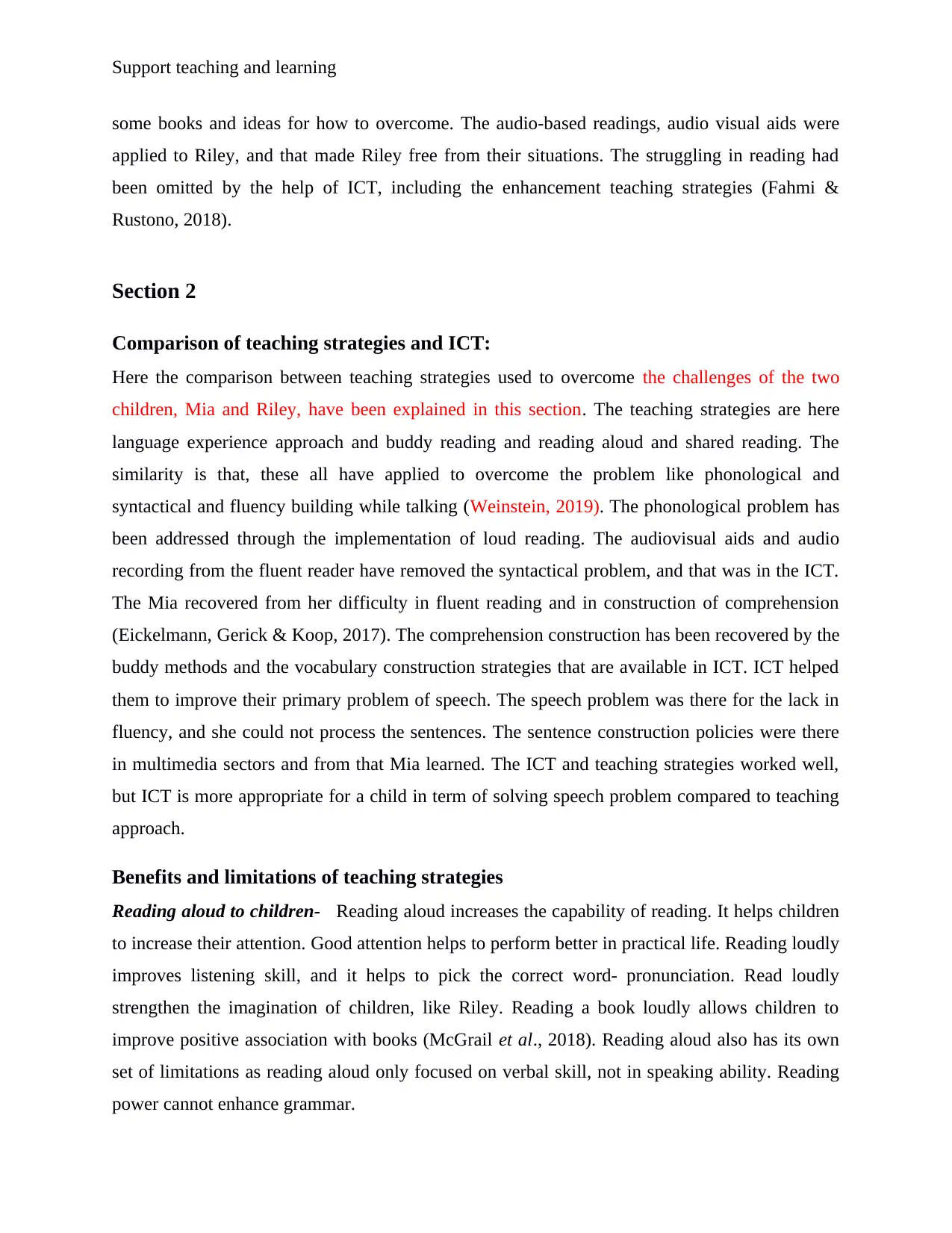
Support teaching and learning
some books and ideas for how to overcome. The audio-based readings, audio visual aids were
applied to Riley, and that made Riley free from their situations. The struggling in reading had
been omitted by the help of ICT, including the enhancement teaching strategies (Fahmi &
Rustono, 2018).
Section 2
Comparison of teaching strategies and ICT:
Here the comparison between teaching strategies used to overcome the challenges of the two
children, Mia and Riley, have been explained in this section. The teaching strategies are here
language experience approach and buddy reading and reading aloud and shared reading. The
similarity is that, these all have applied to overcome the problem like phonological and
syntactical and fluency building while talking (Weinstein, 2019). The phonological problem has
been addressed through the implementation of loud reading. The audiovisual aids and audio
recording from the fluent reader have removed the syntactical problem, and that was in the ICT.
The Mia recovered from her difficulty in fluent reading and in construction of comprehension
(Eickelmann, Gerick & Koop, 2017). The comprehension construction has been recovered by the
buddy methods and the vocabulary construction strategies that are available in ICT. ICT helped
them to improve their primary problem of speech. The speech problem was there for the lack in
fluency, and she could not process the sentences. The sentence construction policies were there
in multimedia sectors and from that Mia learned. The ICT and teaching strategies worked well,
but ICT is more appropriate for a child in term of solving speech problem compared to teaching
approach.
Benefits and limitations of teaching strategies
Reading aloud to children- Reading aloud increases the capability of reading. It helps children
to increase their attention. Good attention helps to perform better in practical life. Reading loudly
improves listening skill, and it helps to pick the correct word- pronunciation. Read loudly
strengthen the imagination of children, like Riley. Reading a book loudly allows children to
improve positive association with books (McGrail et al., 2018). Reading aloud also has its own
set of limitations as reading aloud only focused on verbal skill, not in speaking ability. Reading
power cannot enhance grammar.
some books and ideas for how to overcome. The audio-based readings, audio visual aids were
applied to Riley, and that made Riley free from their situations. The struggling in reading had
been omitted by the help of ICT, including the enhancement teaching strategies (Fahmi &
Rustono, 2018).
Section 2
Comparison of teaching strategies and ICT:
Here the comparison between teaching strategies used to overcome the challenges of the two
children, Mia and Riley, have been explained in this section. The teaching strategies are here
language experience approach and buddy reading and reading aloud and shared reading. The
similarity is that, these all have applied to overcome the problem like phonological and
syntactical and fluency building while talking (Weinstein, 2019). The phonological problem has
been addressed through the implementation of loud reading. The audiovisual aids and audio
recording from the fluent reader have removed the syntactical problem, and that was in the ICT.
The Mia recovered from her difficulty in fluent reading and in construction of comprehension
(Eickelmann, Gerick & Koop, 2017). The comprehension construction has been recovered by the
buddy methods and the vocabulary construction strategies that are available in ICT. ICT helped
them to improve their primary problem of speech. The speech problem was there for the lack in
fluency, and she could not process the sentences. The sentence construction policies were there
in multimedia sectors and from that Mia learned. The ICT and teaching strategies worked well,
but ICT is more appropriate for a child in term of solving speech problem compared to teaching
approach.
Benefits and limitations of teaching strategies
Reading aloud to children- Reading aloud increases the capability of reading. It helps children
to increase their attention. Good attention helps to perform better in practical life. Reading loudly
improves listening skill, and it helps to pick the correct word- pronunciation. Read loudly
strengthen the imagination of children, like Riley. Reading a book loudly allows children to
improve positive association with books (McGrail et al., 2018). Reading aloud also has its own
set of limitations as reading aloud only focused on verbal skill, not in speaking ability. Reading
power cannot enhance grammar.
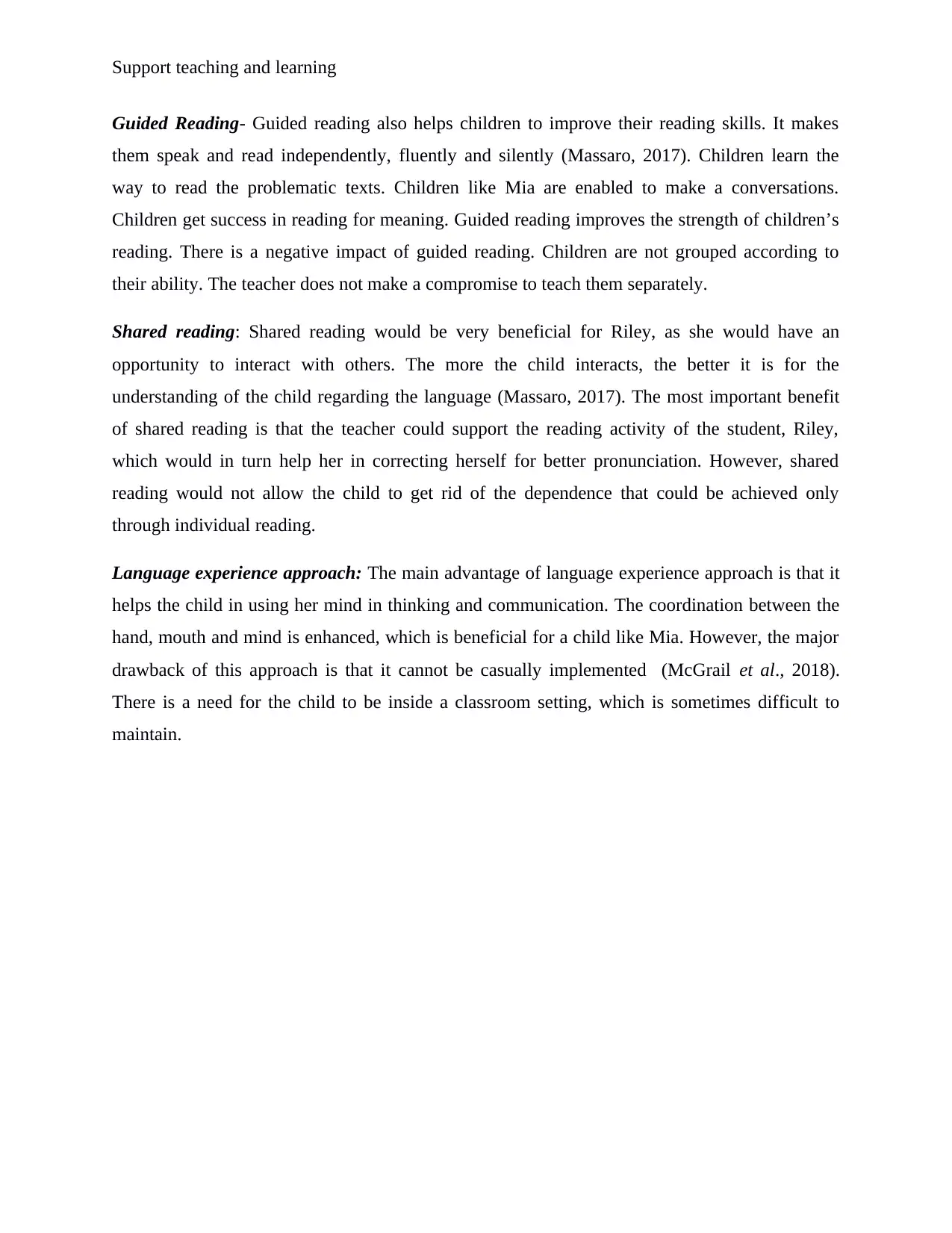
Support teaching and learning
Guided Reading- Guided reading also helps children to improve their reading skills. It makes
them speak and read independently, fluently and silently (Massaro, 2017). Children learn the
way to read the problematic texts. Children like Mia are enabled to make a conversations.
Children get success in reading for meaning. Guided reading improves the strength of children’s
reading. There is a negative impact of guided reading. Children are not grouped according to
their ability. The teacher does not make a compromise to teach them separately.
Shared reading: Shared reading would be very beneficial for Riley, as she would have an
opportunity to interact with others. The more the child interacts, the better it is for the
understanding of the child regarding the language (Massaro, 2017). The most important benefit
of shared reading is that the teacher could support the reading activity of the student, Riley,
which would in turn help her in correcting herself for better pronunciation. However, shared
reading would not allow the child to get rid of the dependence that could be achieved only
through individual reading.
Language experience approach: The main advantage of language experience approach is that it
helps the child in using her mind in thinking and communication. The coordination between the
hand, mouth and mind is enhanced, which is beneficial for a child like Mia. However, the major
drawback of this approach is that it cannot be casually implemented (McGrail et al., 2018).
There is a need for the child to be inside a classroom setting, which is sometimes difficult to
maintain.
Guided Reading- Guided reading also helps children to improve their reading skills. It makes
them speak and read independently, fluently and silently (Massaro, 2017). Children learn the
way to read the problematic texts. Children like Mia are enabled to make a conversations.
Children get success in reading for meaning. Guided reading improves the strength of children’s
reading. There is a negative impact of guided reading. Children are not grouped according to
their ability. The teacher does not make a compromise to teach them separately.
Shared reading: Shared reading would be very beneficial for Riley, as she would have an
opportunity to interact with others. The more the child interacts, the better it is for the
understanding of the child regarding the language (Massaro, 2017). The most important benefit
of shared reading is that the teacher could support the reading activity of the student, Riley,
which would in turn help her in correcting herself for better pronunciation. However, shared
reading would not allow the child to get rid of the dependence that could be achieved only
through individual reading.
Language experience approach: The main advantage of language experience approach is that it
helps the child in using her mind in thinking and communication. The coordination between the
hand, mouth and mind is enhanced, which is beneficial for a child like Mia. However, the major
drawback of this approach is that it cannot be casually implemented (McGrail et al., 2018).
There is a need for the child to be inside a classroom setting, which is sometimes difficult to
maintain.
Paraphrase This Document
Need a fresh take? Get an instant paraphrase of this document with our AI Paraphraser
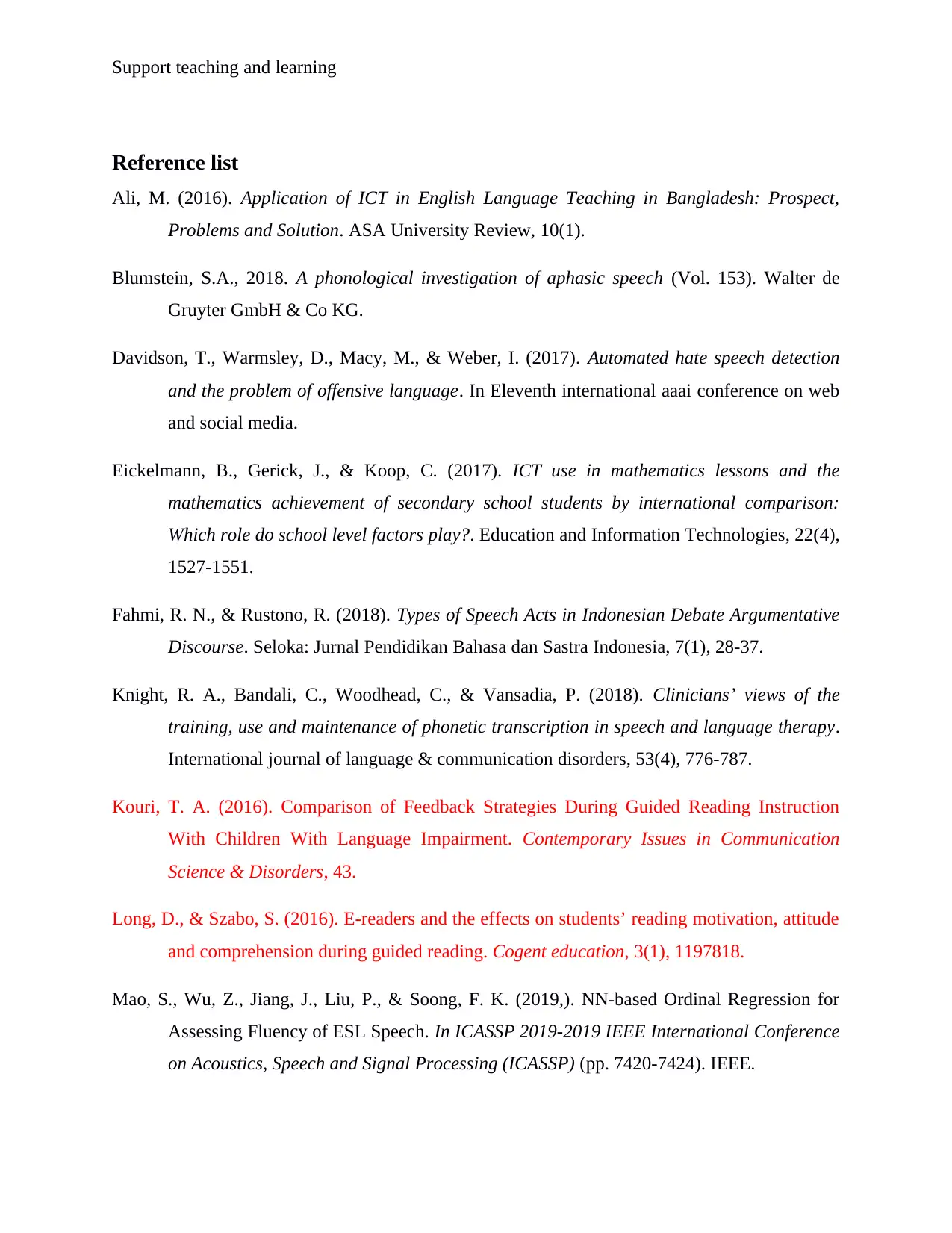
Support teaching and learning
Reference list
Ali, M. (2016). Application of ICT in English Language Teaching in Bangladesh: Prospect,
Problems and Solution. ASA University Review, 10(1).
Blumstein, S.A., 2018. A phonological investigation of aphasic speech (Vol. 153). Walter de
Gruyter GmbH & Co KG.
Davidson, T., Warmsley, D., Macy, M., & Weber, I. (2017). Automated hate speech detection
and the problem of offensive language. In Eleventh international aaai conference on web
and social media.
Eickelmann, B., Gerick, J., & Koop, C. (2017). ICT use in mathematics lessons and the
mathematics achievement of secondary school students by international comparison:
Which role do school level factors play?. Education and Information Technologies, 22(4),
1527-1551.
Fahmi, R. N., & Rustono, R. (2018). Types of Speech Acts in Indonesian Debate Argumentative
Discourse. Seloka: Jurnal Pendidikan Bahasa dan Sastra Indonesia, 7(1), 28-37.
Knight, R. A., Bandali, C., Woodhead, C., & Vansadia, P. (2018). Clinicians’ views of the
training, use and maintenance of phonetic transcription in speech and language therapy.
International journal of language & communication disorders, 53(4), 776-787.
Kouri, T. A. (2016). Comparison of Feedback Strategies During Guided Reading Instruction
With Children With Language Impairment. Contemporary Issues in Communication
Science & Disorders, 43.
Long, D., & Szabo, S. (2016). E-readers and the effects on students’ reading motivation, attitude
and comprehension during guided reading. Cogent education, 3(1), 1197818.
Mao, S., Wu, Z., Jiang, J., Liu, P., & Soong, F. K. (2019,). NN-based Ordinal Regression for
Assessing Fluency of ESL Speech. In ICASSP 2019-2019 IEEE International Conference
on Acoustics, Speech and Signal Processing (ICASSP) (pp. 7420-7424). IEEE.
Reference list
Ali, M. (2016). Application of ICT in English Language Teaching in Bangladesh: Prospect,
Problems and Solution. ASA University Review, 10(1).
Blumstein, S.A., 2018. A phonological investigation of aphasic speech (Vol. 153). Walter de
Gruyter GmbH & Co KG.
Davidson, T., Warmsley, D., Macy, M., & Weber, I. (2017). Automated hate speech detection
and the problem of offensive language. In Eleventh international aaai conference on web
and social media.
Eickelmann, B., Gerick, J., & Koop, C. (2017). ICT use in mathematics lessons and the
mathematics achievement of secondary school students by international comparison:
Which role do school level factors play?. Education and Information Technologies, 22(4),
1527-1551.
Fahmi, R. N., & Rustono, R. (2018). Types of Speech Acts in Indonesian Debate Argumentative
Discourse. Seloka: Jurnal Pendidikan Bahasa dan Sastra Indonesia, 7(1), 28-37.
Knight, R. A., Bandali, C., Woodhead, C., & Vansadia, P. (2018). Clinicians’ views of the
training, use and maintenance of phonetic transcription in speech and language therapy.
International journal of language & communication disorders, 53(4), 776-787.
Kouri, T. A. (2016). Comparison of Feedback Strategies During Guided Reading Instruction
With Children With Language Impairment. Contemporary Issues in Communication
Science & Disorders, 43.
Long, D., & Szabo, S. (2016). E-readers and the effects on students’ reading motivation, attitude
and comprehension during guided reading. Cogent education, 3(1), 1197818.
Mao, S., Wu, Z., Jiang, J., Liu, P., & Soong, F. K. (2019,). NN-based Ordinal Regression for
Assessing Fluency of ESL Speech. In ICASSP 2019-2019 IEEE International Conference
on Acoustics, Speech and Signal Processing (ICASSP) (pp. 7420-7424). IEEE.
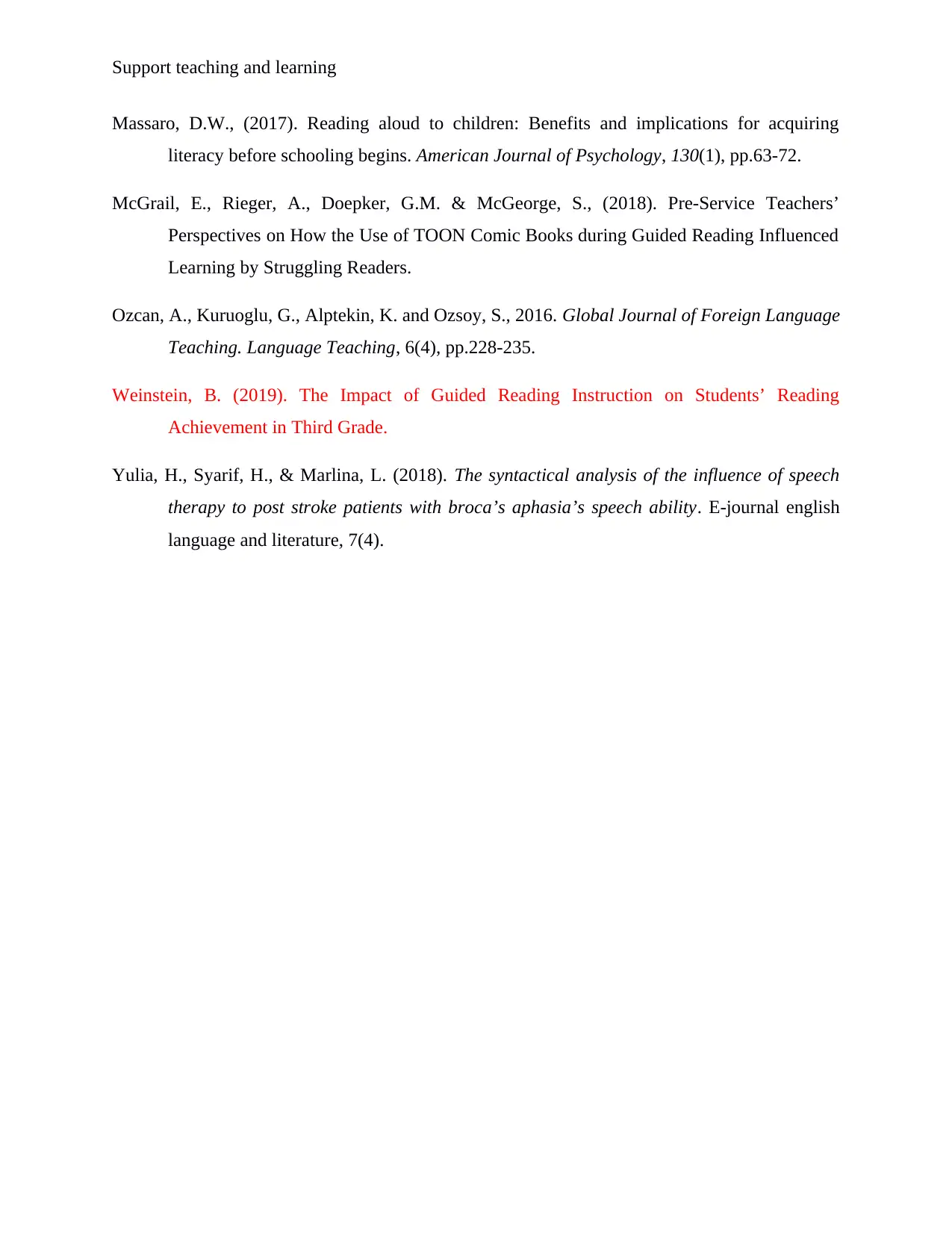
Support teaching and learning
Massaro, D.W., (2017). Reading aloud to children: Benefits and implications for acquiring
literacy before schooling begins. American Journal of Psychology, 130(1), pp.63-72.
McGrail, E., Rieger, A., Doepker, G.M. & McGeorge, S., (2018). Pre-Service Teachers’
Perspectives on How the Use of TOON Comic Books during Guided Reading Influenced
Learning by Struggling Readers.
Ozcan, A., Kuruoglu, G., Alptekin, K. and Ozsoy, S., 2016. Global Journal of Foreign Language
Teaching. Language Teaching, 6(4), pp.228-235.
Weinstein, B. (2019). The Impact of Guided Reading Instruction on Students’ Reading
Achievement in Third Grade.
Yulia, H., Syarif, H., & Marlina, L. (2018). The syntactical analysis of the influence of speech
therapy to post stroke patients with broca’s aphasia’s speech ability. E-journal english
language and literature, 7(4).
Massaro, D.W., (2017). Reading aloud to children: Benefits and implications for acquiring
literacy before schooling begins. American Journal of Psychology, 130(1), pp.63-72.
McGrail, E., Rieger, A., Doepker, G.M. & McGeorge, S., (2018). Pre-Service Teachers’
Perspectives on How the Use of TOON Comic Books during Guided Reading Influenced
Learning by Struggling Readers.
Ozcan, A., Kuruoglu, G., Alptekin, K. and Ozsoy, S., 2016. Global Journal of Foreign Language
Teaching. Language Teaching, 6(4), pp.228-235.
Weinstein, B. (2019). The Impact of Guided Reading Instruction on Students’ Reading
Achievement in Third Grade.
Yulia, H., Syarif, H., & Marlina, L. (2018). The syntactical analysis of the influence of speech
therapy to post stroke patients with broca’s aphasia’s speech ability. E-journal english
language and literature, 7(4).
1 out of 9
Your All-in-One AI-Powered Toolkit for Academic Success.
+13062052269
info@desklib.com
Available 24*7 on WhatsApp / Email
![[object Object]](/_next/static/media/star-bottom.7253800d.svg)
Unlock your academic potential
© 2024 | Zucol Services PVT LTD | All rights reserved.


